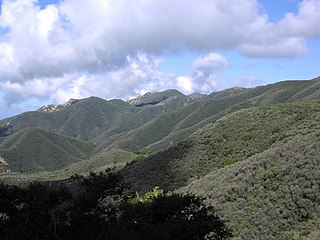
Chaparral is a shrubland plant community found primarily in California, in southern Oregon and in the northern portion of the Baja California Peninsula in Mexico. It is shaped by a Mediterranean climate and infrequent, high-intensity crown fires.

Ceanothus is a genus of about 50–60 species of nitrogen-fixing shrubs and small trees in the buckthorn family (Rhamnaceae). Common names for members of this genus are buckbrush, California lilac, soap bush, or just ceanothus. "Ceanothus" comes from Ancient Greek: κεάνωθος (keanōthos), which was applied by Theophrastus to an Old World plant believed to be Cirsium arvense.

Pinus ponderosa, commonly known as the ponderosa pine, bull pine, blackjack pine, western yellow-pine, or filipinus pine is a very large pine tree species of variable habitat native to mountainous regions of western North America. It is the most widely distributed pine species in North America.

Toxicodendron diversilobum, commonly named Pacific poison oak or western poison oak, is a woody vine or shrub in the sumac family, Anacardiaceae. It is widely distributed in western North America, inhabiting conifer and mixed broadleaf forests, woodlands, grasslands, and chaparral biomes. Peak flowering occurs in May. Like other members of the genus Toxicodendron, T. diversilobum causes itching and allergic rashes in most people after contact by touch or smoke inhalation. Despite its name, it is not closely related to oaks, nor is it a true tree.
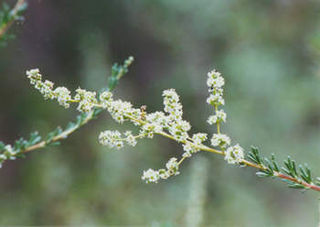
Adenostoma fasciculatum, commonly known as chamise or greasewood, is a flowering plant native to California and Baja California. This shrub is one of the most widespread plants of the California chaparral ecoregion. Chamise produces a specialized lignotuber underground and at the base of the stem, known as a burl, that allow it to resprout after fire has off burned its stems. It is noted for its greasy, resinous foliage, and its status as one of California's most iconic chaparral shrubs.

Ceanothus integerrimus, known by the common name deer brush, is a species of woody shrub in the family Rhamnaceae, native to the western United States in Arizona, New Mexico, California, Oregon, and Washington. It grows in montane chaparral and woodlands regions, in hardwood forests, and in fir, spruce, and Ponderosa pine plant communities, being most abundant in the California chaparral and woodlands and Sierra Nevada.
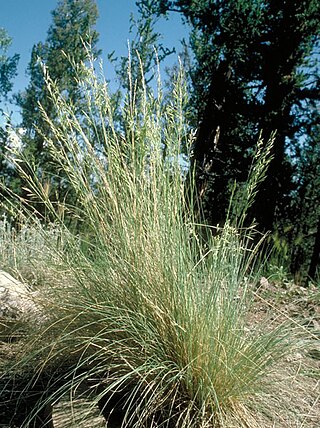
Festuca arizonica, commonly called Arizona fescue, is a grass found in western North America, in the southwest United States and northern Mexico. This species also has the common names mountain bunchgrass and pinegrass.

Ceanothus cuneatus is a species of flowering shrub known by the common names buckbrush and wedgeleaf ceanothus.
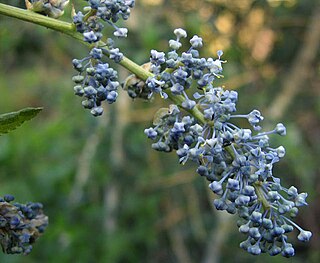
Ceanothus leucodermis, with the common names chaparral whitethorn or chaparral white thorn, is a species of shrub in the family Rhamnaceae. This Ceanothus is an importance browse for several types of ungulate, such as the mule deer and bighorn sheep, who prefer the new growth and shoots to the older, spiny parts.

Ceanothus prostratus is a species of shrub in the family Rhamnaceae. Common names include prostrate ceanothus, pinemat, and mahala mat. It is native to the Pacific Northwest of the United States where it grows in coniferous forests and open plateaus.

Ceanothus sanguineus is a species of shrub in the family Rhamnaceae known by the common name redstem ceanothus. It is native to western North America from British Columbia to Montana to far northern California; it is also known from Michigan. It grows in temperate coniferous forest habitat in forest openings amidst the conifers. This is an erect shrub approaching 3 meters in maximum height. Its stem is red to purple in color, its woody parts green and hairless when new. The deciduous leaves are alternately arranged and up to about 10 centimeters long. They are thin, light green, oval, and generally edged with glandular teeth. The undersides are sometimes hairy. The inflorescence is a cluster of white flowers up to about 12 centimeters long. The fruit is a three-lobed smooth capsule about 4 millimeters long. This shrub is an important food plant for wild ungulates such as the Rocky Mountain Elk, it is browsed eagerly by many types of livestock, and the seed is consumed by many types of animals.

Ceanothus velutinus, with the common names snowbrush ceanothus, red root, tobacco brush, and sticky laurel, is a species of shrub in the family Rhamnaceae. It is native to western North America from British Columbia to California to Colorado.

The Sierra Nevada lower montane forest is a plant community along a strip along the western and eastern edges of the Sierra Nevada mountain range in California. This zone is also known as a yellow pine forest.

Ceanothus americanus is a species of Ceanothus shrub native to North America. Common names include New Jersey tea, Jersey tea ceanothus, variations of red root, mountain sweet, and wild snowball. New Jersey tea was a name coined during the American Revolution, because its leaves were used as a substitute for imported tea.

Thalictrum fendleri is a species of flowering plant in the buttercup family known by the common name Fendler's meadow-rue. It is named in honor of Augustus Fendler.

Echinocereus fendleri is a species of cactus known by the common names pinkflower hedgehog cactus and Fendler's hedgehog cactus. It is named in honor of Augustus Fendler.

Garrya wrightii is a species of flowering plant in the family Garryaceae known by the common names Wright's silktassel, quinine-bush, coffee berry, bearberry, feverbush, and grayleaf dogwood.

Gaylussacia frondosa is a species of flowering plant in the heath family known by the common names dangleberry and blue huckleberry. It is native to the eastern United States, where it occurs from New Hampshire to South Carolina.

Ceanothus herbaceus, also known as Jersey tea, is a species of shrub in the family Rhamnaceae and is similar to Ceanothus americanus and Ceanothus sanguineus. It is a perennial shrub which is native to North America.
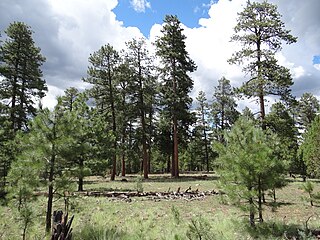
Ponderosa pine forest is a plant association and plant community dominated by ponderosa pine and found in western North America. It is found from the British Columbia to Durango, Mexico. In the south and east, ponderosa pine forest is the climax forest, while in the more northern part of its range, it can transition to Douglas-fir or grand fir, or white fir forests. Understory species depends on location. Fire suppression has led to insect outbreaks in ponderosa pine forests.




















